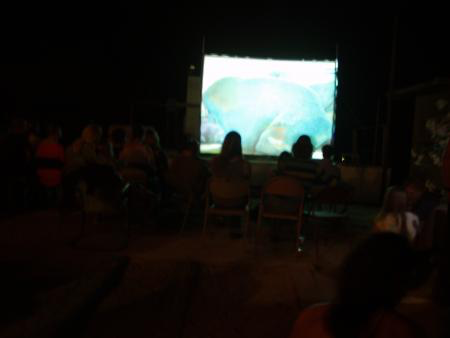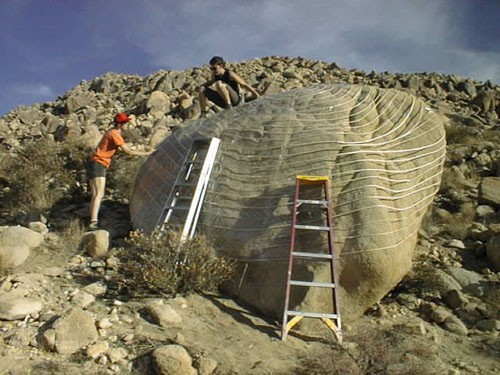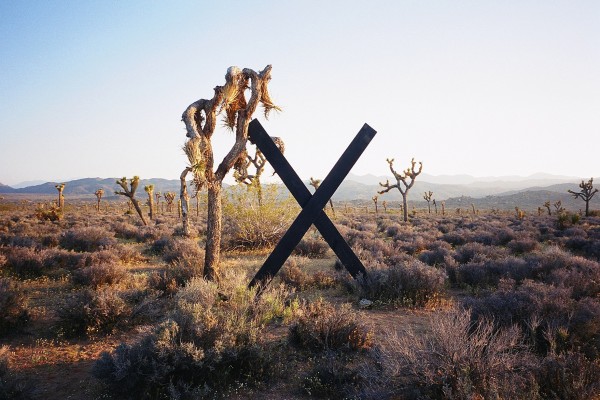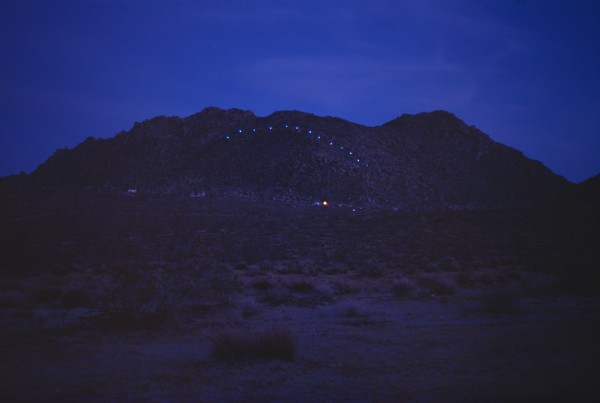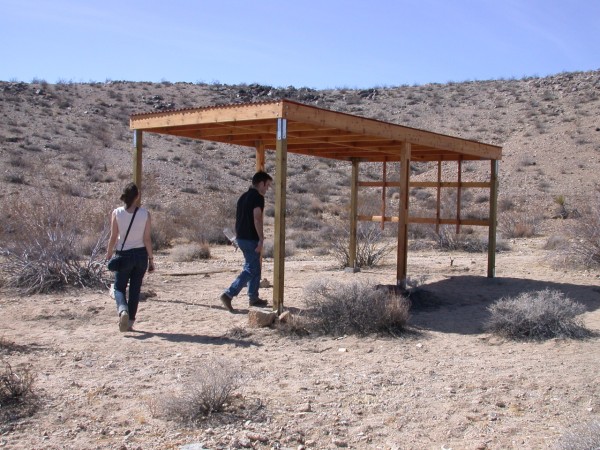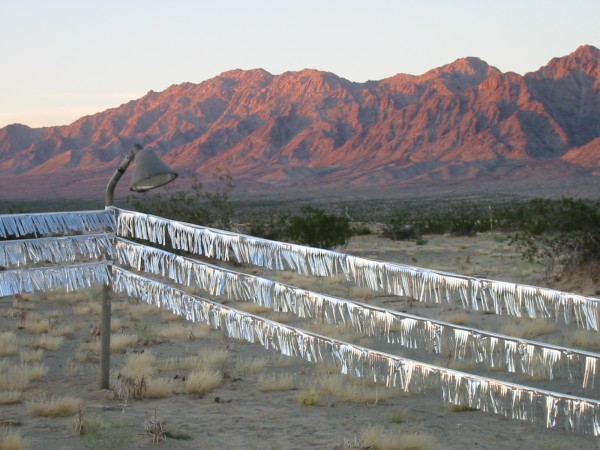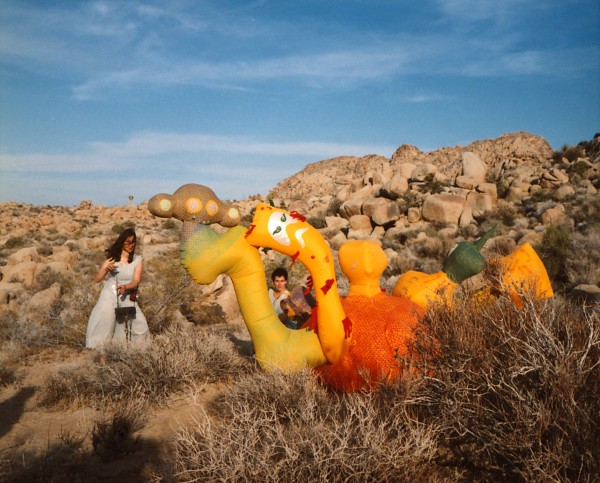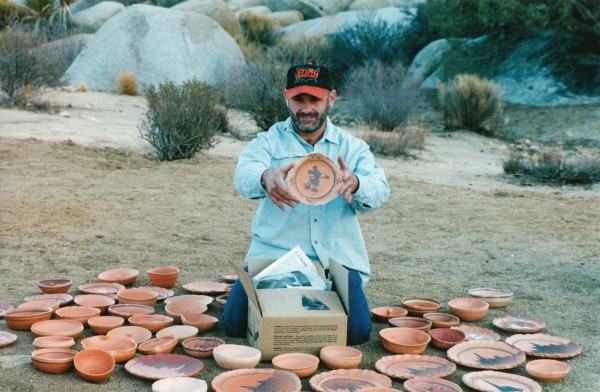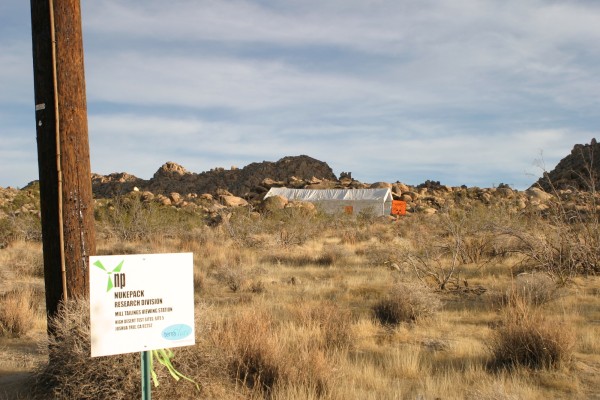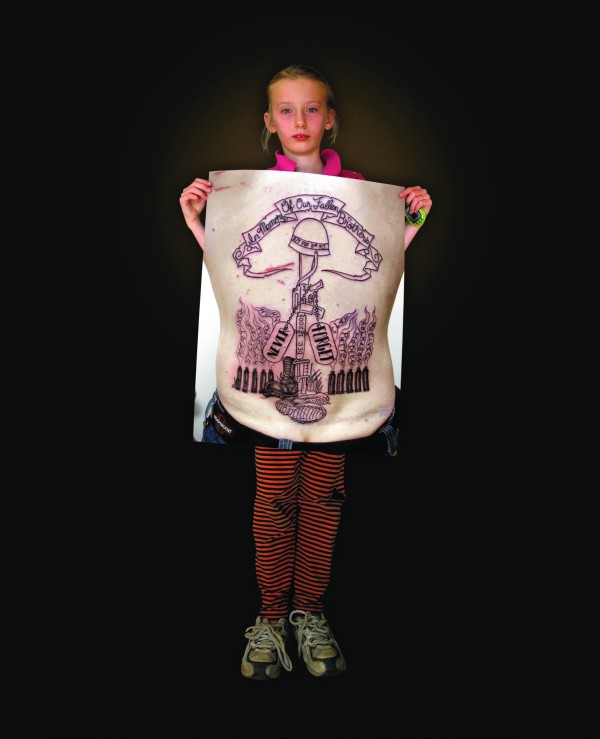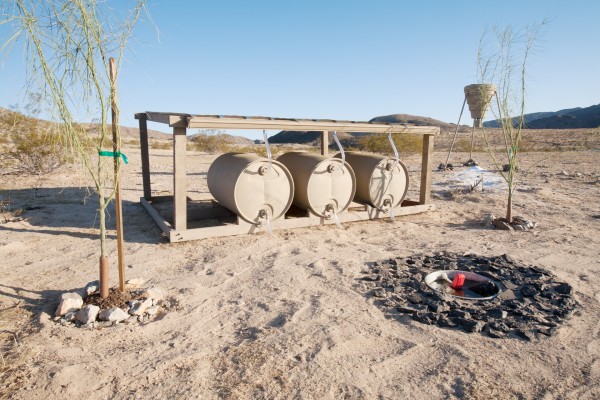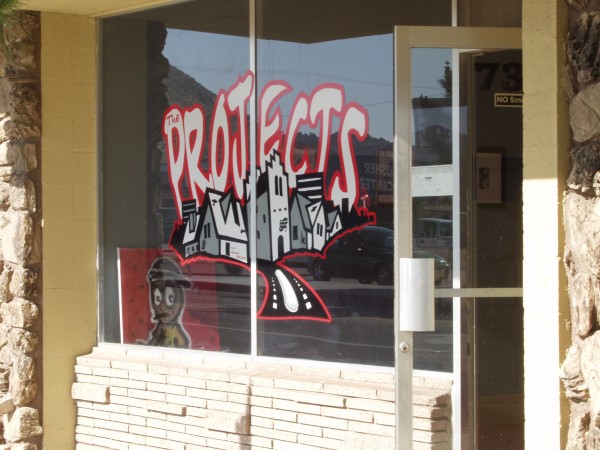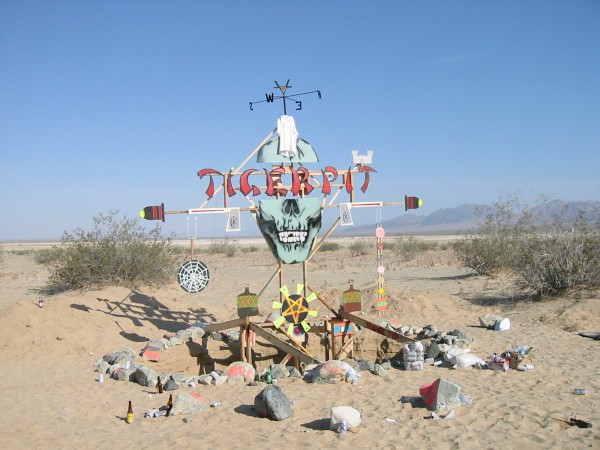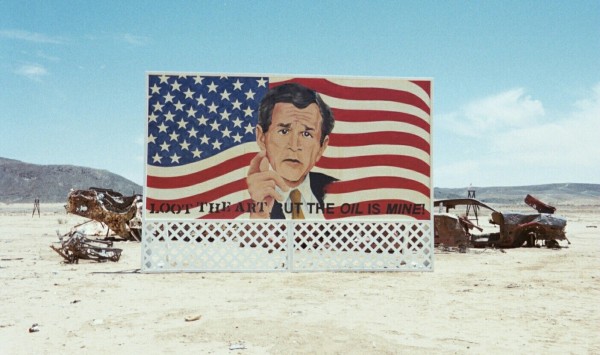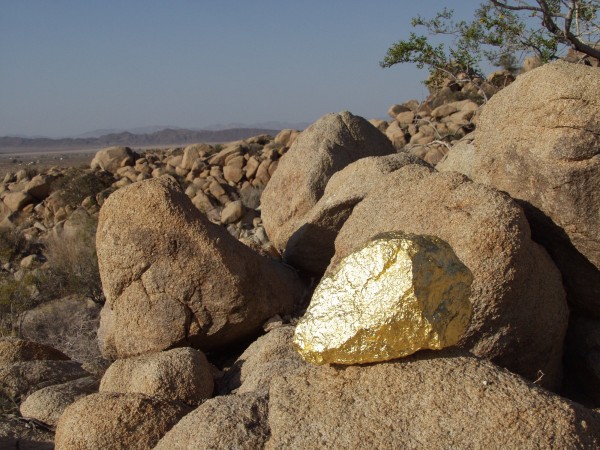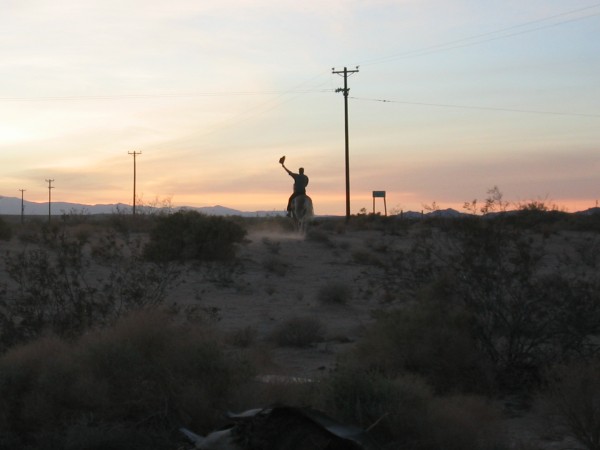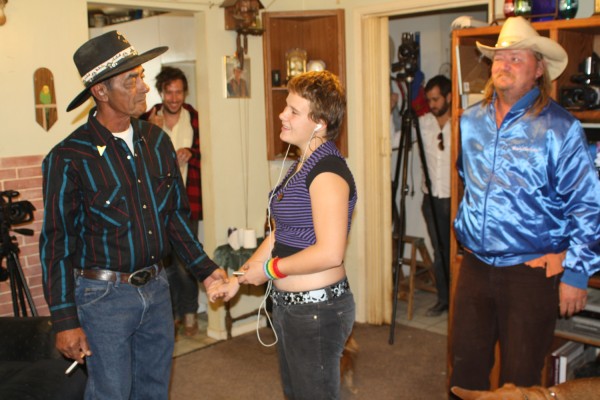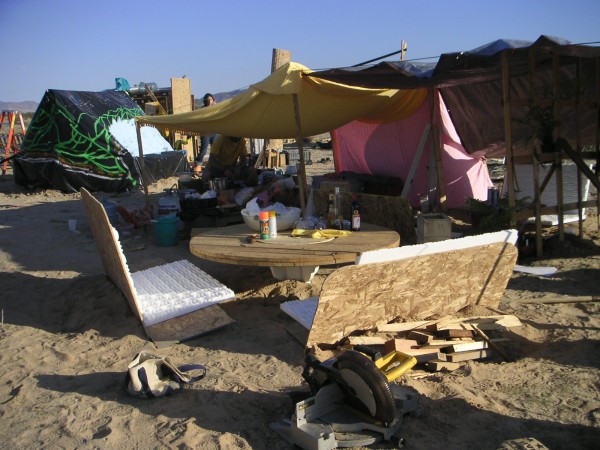- Videos Curated by John Connelly at The Palms
- Souvenir Collab
- Videos Curated by John Connelly
- Sauna
- Untitled by Wade Guyton
- Hillside as Darkness
- Carport
- Noah Purifoy Foundation
- Untitled by Virginia Poundstone
- Monster Tree
- Two Fires / California Adventure
- The Payphone
- Untitled by Lisi Raskin
- Give and Take: Iraq War Memorial Tattoo Project
- Black Propaganda at Melancholy Ranch
- Church of the Cult of P / Desserts in the Desert
- CA Truck Heads
- Mojave Desert Mule Deer Refuge
- Palms
- The Projects
- The Inhabitant of the Watchtower
- Tiger Pit
- Untitled by Hal McFeely
- The Boneshakers
- The History of the Last Five Minutes (No.1)
- Gold Nugget
- Untitled by Jack Pierson
- HDTS 1 Catalogue
- The End
- Wood Tower (Gets the Job Done)
- White Russians
- Space Post
- Accident in Oriental California
- Here
- Lost Desert Stage
- I'm Sorry
- How to be a Joshua Tree
¸.·ℳ¸.·´¨)𐌄 ¸.·*¨ɱ)
(¸*.ᴑ·´ (¸.ʀ·´ .·´🄨 ¸
Lisa Anne: The first time we had dinner at the Palms, they were a bit overwhelmed by the crowd. We told them to expect a large group, but they were barely prepared for the numbers that showed up. Everyone was hungry, and there just wasn’t a system in place for feeding so many. At one point I looked into the kitchen and there was Andrea flipping burgers!
Andrea: Jennifer Nocon once tried to show her video on the TVs at the bar during the World Series. They handful of regulars could put up with hundreds of HDTS people, but when it came to the TV they put their foot down.
Memory of
¸.·ℳ¸.·´¨)𐌄 ¸.·*¨ɱ)
(¸*.ᴑ·´ (¸.ʀ·´ .·´🄨 ¸
On October 12th, we were in Joshua Tree, and we stayed in the last Wagon Station available. We were supposed to camp in Joshua Tree National Park, but this was during the government shutdown, and it was closed! Matt made up an excuse about why we should have each others’ parents’ phone numbers, and he slipped away to call my dad to ask for my hand in marriage (very traditional family), he also sang along with Whitney Houston’s version of “I will always love you” to me in the Wagon Station that that night while I laughed uncontrollably.
The morning of October 14th, we had breakfast at Bob Dornberger’s Secret Restaurant before leaving town for Kingman, Arizona. Our first stop was at the Hill Top Motel to install our souvenir for our project. We participated in Documart, and we were the first couple that they “documarried.” Our Hill Top souvenir had a fortune cookie component, so we ate the fortune cookie, and our fortune said “seize from every moment its uniqueness, especially this week” so we kept that on the dashboard all week.
We set up our tents for Catherine Stebbins’ project “Desert Traces.” Matt pulled off to the side of the road as we were headed out to dinner to celebrate our one-year anniversary. He said he’d made a special souvenir for me, and pulled out a packet like the rest of the ones we had made, and it had a little vial with dried chaparral leaves in it, which I had used for one of our souvenirs. He poured the leaves into my hand, and a sparkly diamond poured out with them. It took me a minute to really process what was happening, so I didn’t hear anything he said. He was nervous because he didn’t hear me say yes. We tried to find fancy food in Kingman to celebrate, but then decided it would be way better to have Chinese food (we had eaten Chinese food on our previous visit—which is why there was a fortune cookie in the souvenir we made) so we found one with a buffet. We had egg rolls and egg drop soup and green jello, and they actually had champagne, so we toasted, and watched football and sat at the bar. On our way back to camp, we bought wine from Walgreens with plastic cups. We sat around the fire and shared wine and stories with people, and kissed and we were engaged.
¸.·ℳ¸.·´¨)𐌄 ¸.·*¨ɱ)
(¸*.ᴑ·´ (¸.ʀ·´ .·´🄨 ¸
I think it was my idea to do a drive-in movie theater on my property. I’m not totally sure. I would bring my video projector, which were kind of rare at the time—back then they were expensive—and John did the programming.
Mungo had a really great video that consisted of Road Runner cartoons that he had taken the characters out of so it was just cartoon images of desert scenes.
Doing the screening in the desert at night was really effective. We rented a generator to run them.
Joel Otterson had the idea of buying haystacks and setting them up like a roman amphitheater which looked great.
There was a perfectly full moon. A friend of mine, a Mexican curator that came out with his wife, had a bottle of mezcal with the worm in it and we sat under a Joshua Tree and drank it. It was amazing.
The movies were playing on a loop. People could trickle in and out.
Then afterward, there was some bar that people went to afterward and we stayed up drinking late.
The next day was Joel’s pig roast.
¸.·ℳ¸.·´¨)𐌄 ¸.·*¨ɱ)
(¸*.ᴑ·´ (¸.ʀ·´ .·´🄨 ¸
I can’t remember exactly who came up with the brilliant idea of screening Mungo Thomson’s The American Desert (For Chuck Jones) in the middle of the desert, however, I did take charge of organizing a larger video program to supplement the screening and added videos by Forcefield and Assume Vivid Astro Focus.
After that evening, curating a video program became an ongoing contribution of mine that I enjoyed in addition to inviting artists to create projects for each new HDTS event. The night with Mungo’s piece was by far the most memorable of the video programs, if not for the excruciating cold, technical hurdles, and trippy context of the videos themselves, then for the sheer newness (and craziness) of what we were doing out there—absurdly out of place, sharing in a great art experience out in the middle of the desert.
¸.·ℳ¸.·´¨)𐌄 ¸.·*¨ɱ)
(¸*.ᴑ·´ (¸.ʀ·´ .·´🄨 ¸
The videos were shown on a screen that our friend Till Lux made for us out of chain link fence and straw bale seating. (Till was in his early 20s, grew up in Pioneertown, and ran the local sign shop. He was somehow also a Canadian citizen and had a maple leaf tattoo on the inside of his lower lip.)
It was a freezing that night up in Pioneertown and everyone was so cold while watching the videos. (We have since learned that the Gamma Gulch site is too cold for nighttime activities in the fall and winter.) Either Andy or John drove down to Palm Springs to rent a Honda 2000 generator. I think they maybe even rented two generators because they were worried that one might fail, which it did.
¸.·ℳ¸.·´¨)𐌄 ¸.·*¨ɱ)
(¸*.ᴑ·´ (¸.ʀ·´ .·´🄨 ¸
The first HDTS was in October, and we set up an outdoor screening room in Pioneertown. I don’t think anyone could have predicted how freezing it would be that night. Those of us from the big city think “desert” means hot. As Mungo Thomson’s Roadrunner-free desert landscapes played on the big screen, I slowly lost all feeling in my feet.
Memory of
¸.·ℳ¸.·´¨)𐌄 ¸.·*¨ɱ)
(¸*.ᴑ·´ (¸.ʀ·´ .·´🄨 ¸
Marie has been in a bunch of HDTS events. She was my student at Yale in the early 1990s and has an affinity with the desert [she was born in 29 Palms]. The Sauna turned out to be a very good idea because it was so cold up on the Pioneertown parcel the night we were trying to watch videos. People kept crawling in to get warm. I think her dad was there heating the rocks up over a fire.
¸.·ℳ¸.·´¨)𐌄 ¸.·*¨ɱ)
(¸*.ᴑ·´ (¸.ʀ·´ .·´🄨 ¸
I asked Wade to participate in the second HDTS after showing his work in a three-person exhibition at my gallery in New York alongside Mungo Thomson and Matthew Brannon. In the show, Wade contributed a beat up and twisted Breuer chair frame sculpture and a series of appropriated installation shots of public works by icons of modernism such as Tony Smith with gigantic X’s over them.
I think everybody was a little perplexed by these gestures at the time. Little did we know how important the “X” iconography would subsequently become in his work. When Wade told me of his plan to place a big black X on Andy’s property I was skeptical but went along with it happily. In retrospect, it’s one of my favorite artist contributions. I remember helping Wade paint the simple wood planks in the hot desert sun, screwing them together and simply propping them up on the parcel.
Memory of
¸.·ℳ¸.·´¨)𐌄 ¸.·*¨ɱ)
(¸*.ᴑ·´ (¸.ʀ·´ .·´🄨 ¸
This was a sort of epic project –Allen Compton is a landscape architect. He designed these solar lights before they were easily commercially available. The plan was to install them in a row on the hill behind my house – but in order to get them to look like they were in a line they actually had to be mounted at all different points on the mountain. His wife Elizabeth would drive down to the Bail Bonds at night with a walkie-talkie and we would climb around in the dark on the boulders with headlamps and try to get them set up right. Allen did a good job making the lights because they actually lasted for quite some time. There was an episode on Z107FM (the local radio station) when people were calling in and speculating about what the lights were. Some people thought they were from the military and some thought they were some sort of landing strip.
Memory of
¸.·ℳ¸.·´¨)𐌄 ¸.·*¨ɱ)
(¸*.ᴑ·´ (¸.ʀ·´ .·´🄨 ¸
The carport was built on the Sunfair 20-acre parcel in North Joshua Tree. It was seemingly stable, but within a few months the entire thing had been stolen – clearly after being carted away piece by piece.
¸.·ℳ¸.·´¨)𐌄 ¸.·*¨ɱ)
(¸*.ᴑ·´ (¸.ʀ·´ .·´🄨 ¸
I discovered Noah’s site by accident one day while driving around in North Joshua Tree. At first I would do stealth drive-bys whenever people would come to visit to show them his amazing site. Noah was still alive at that time, and I’m not sure if visitors were supposed to arrive unannounced. But I was obsessed with his work and felt that it embodied everything that I was interested in achieving in the desert. I loved that it was a lifelong undertaking – that it was inextricably grounded in its location - and that it was smart and political and culturally relevant – this seemed especially brave in an area that was very white and often conservative at the time. Eventually I was able to meet Noah by communicating with Sue Welsh who ran his foundation and asked if we could include his art site in our event.
¸.·ℳ¸.·´¨)𐌄 ¸.·*¨ɱ)
(¸*.ᴑ·´ (¸.ʀ·´ .·´🄨 ¸
After the official after party at a saloon that ran out of food and was located at the intersection of two dirt roads, a bunch of people drove out to the Sunken Car Dealership in the middle of the night. Outkast’s song, Bombs Over Baghdad, cranked from Frank Benson’s truck and Xavier Cha, Justin Beal, Matt Johnson, Shana Lutker, myself (who am I missing?! other than a few random people who had just come from Burning Man) drank and danced until it was too cold to stay and/or Frank’s truck got caught in the sand and everyone had to push it out.
Memory of
¸.·ℳ¸.·´¨)𐌄 ¸.·*¨ɱ)
(¸*.ᴑ·´ (¸.ʀ·´ .·´🄨 ¸
I met Christy and Fabienne when they were MFA students at Columbia. They came out and did this performance on the upper part of the “Behind the Bail Bonds” parcel.
First one of them started playing a theremin – Then the other one came wandering out of the boulders with a suitcase. They were both wearing these shiny dresses that reminded me of space alien pioneer dresses. Fabienne set down the suitcase and opened it up and this inflatable creature slowly emerged out of it to the music of the theremin.
¸.·ℳ¸.·´¨)𐌄 ¸.·*¨ɱ)
(¸*.ᴑ·´ (¸.ʀ·´ .·´🄨 ¸
Joel sent a project description that had something to do with Disneyland and the history of ancient California—it was all tied together in a really smart way. He was teaching ceramics at UCLA and brought his students out who made clay dishes using an ancient technique. He was going to start a fire at 6am so by 6pm it would be hot and big enough to fire the dishes. During that time he was also going to roast a pig using an ancho rub recipe. The pig roast would take 10 hours on the spit, and then the fire would get hot enough so when people came he would give them the plates and they could fire them by placing them in the fire.
We had the firewood delivered the day before—then later that day, as we were driving down Gods Way Love and getting closer to the property, I ran into a caravan of menacing looking people who circled around my car in order to make us stop. They asked if I had anything to do with this property. I said yes, it was mine. And they asked what I was going to do with all that firewood. I said we’re going to roast a pig. They said if you do, you’re going to be arrested the moment you light the fire. They were really angry and super aggressive about it—they said you can’t have fire here, this is a fire zone. I said, I don’t want to burn anything, we are trying to do something nice for the area.
They started to calm down after a while, and thought HDTS was a cool idea. Joel had showed up by then with the pig and they said we couldn’t have the fire on my parcel, but let’s talk to Garth. Garth was sort of a guru in the community and apparently, I had stepped into some kind of subculture, which makes sense out in the desert. Garth showed up in his robe with no shoes. We explained what we were doing and he invited us to do the fire at his property because he had a fire pit and was the fire god.
He told us how to get to his property and it looked like something out of Indiana Jones. He had all kinds of exotic vegetation growing out of the sides of boulders and a teepee, and a lake of moondust that he had collected and Joel and Garth ended up becoming friends. The only problem with it was that the advertisement for the pig roast was for my property so I had to spend the whole next day sitting on the haystacks and anytime anyone came I would have to give them directions to Garth’s. But then I finally made it over there and it was a huge hit! They ate that pig from the snout to its tail. They were waiting in line, it was popular.
¸.·ℳ¸.·´¨)𐌄 ¸.·*¨ɱ)
(¸*.ᴑ·´ (¸.ʀ·´ .·´🄨 ¸
We met Garth for the first time at HDTS 1, when he graciously lent us his fire pit for Joel Otterson’s pig roast after voicing concern that we might burn down the desert if we tried it on one of our own sites—he has a small magnetic “lake” of iron filings found in the desert and an outdoor kitchen. He’s welcomed all of us to explore his grottoes and meets his birds.
Memory of
¸.·ℳ¸.·´¨)𐌄 ¸.·*¨ɱ)
(¸*.ᴑ·´ (¸.ʀ·´ .·´🄨 ¸
Installing the phone at the HDTS site was a tricky proposition. After meeting with the phone company, they ultimately refused to install a dedicated line. There is the technology to set up a cellular and solar payphone that is completely disconnected from the physical grid. I was interested in having an actual wire connecting people together. The idea of physically connecting people is not a new idea but is dying out with the increasing use of wireless media. Additionally, payphones are quickly becoming obsolete.
I ended up running the phone off Andrea’s house line. It was connected by burying almost 1000’ of phone cord. By the end of the weekend my hands were raw from digging in the sand. Andrea helped a little and she had a tour of school kids visit her the same day and some of them helped me dig. Shortly after the show Andrea told me that mice ate through the line so it wasn’t operational beyond HDTS 5. This is something I was warned about.
¸.·ℳ¸.·´¨)𐌄 ¸.·*¨ɱ)
(¸*.ᴑ·´ (¸.ʀ·´ .·´🄨 ¸
Lisi’s project was installed on the parcel not too far from A-Z West called “Behind the Bail Bonds” – it was a pseudo scientific/ecological field-lab set up to analyze and detoxify uranium mill tailings. I remember a few local visitors thinking that her research was based on fact and getting worked up until they were told that it was an art project. Lisi presided over the entire operation as her alter ego.
¸.·ℳ¸.·´¨)𐌄 ¸.·*¨ɱ)
(¸*.ᴑ·´ (¸.ʀ·´ .·´🄨 ¸
In 2005 I proposed a site-specific project which acknowledged that the US had been at war in Iraq for two years, and that our high desert landscape was tied to another desert landscape across the world. Rather than select a spot of land from which to address this, I chose to photograph some of the bodies that traversed these two landscapes: Marines from the nearby Twenty Nine Palms Marine Corps Air Ground Combat Center. I focused on the memorial tattoos that they’d had inscribed upon returning from the Iraq war, many naming the friends and comrades who died. I printed one out as a poster (and later, more) and invited the audience, a mix of Marines, local residents and art folk, to take a copy if they wished. This extended the project to other geographies, literal and psychic.
The project has had a long half-life. At first I was contacted by the Marines pictured in the posters, then by their families, who often asked me to send them copies of the posters. I also fielded requests from an Army psychologist who had treated soldiers; academics studying military social practices and iconography; and peace activists. As word of the project spread I was contacted by two Gold Star Mothers whose sons’ names appeared in the memorial tattoo photographs.
I’m still in touch with some of Marines pictured in the photos I took back in 2006, including Owen McNamara (pictured in this poster). They are still dealing with a lot of war related injuries (including less-visible blast-related brain trauma). Discharged as “Wounded Warriors,” some felt discarded by the Marine Corps after they were no longer useful.
It’s clear from our social media feeds that we find ourselves on different sides of the issues dividing our country. Yet the project continues to urge me to create bridges across class and cultural lines. The Marines trusted me to photograph them, and I reciprocate in part by maintaining the images in a spirit of mutual regard. The posters take up a lot of space in my studio, and I keep wanting to toss them out, but then out of the blue I’ll hear from another Marine asking for copies of his freshly inked memorial. The conversation between two desert landscapes, and between an artist and a group of soldiers, has continued for more than a decade, and seems likely to persist.
¸.·ℳ¸.·´¨)𐌄 ¸.·*¨ɱ)
(¸*.ᴑ·´ (¸.ʀ·´ .·´🄨 ¸
Most of the artists (both emerging and established) do almost everything themselves. As a big promoter of a healthy DIY attitude, I’m still always amazed at how self-sufficient and totally competent people become in these situations. A good example of this is Roman Vasseur, who came out in early April 2005 to realize the second phase of a project that began with an airplane drop of “black propaganda” on a piece of desert owned by Jeremy Deller in Trona, which is several hours north of our own land. Roman wanted to screen a film of the drop on the local television station. He flew in from London while I was away for teaching gigs, so he made the trek out to the desert alone and managed to meet more people in town than I had in my first year there. By the end of his first week he had discovered a local filmmaker, Bob Stephenson, who had shot two films in the area, called Magnum Farce and Filthy Harry (no, they’re not porn!), and he had found a cable network that agreed to screen his film once a week for a year at no cost.
—From Artforum Summer 2005, “A Text About High Desert Test Sites”
¸.·ℳ¸.·´¨)𐌄 ¸.·*¨ɱ)
(¸*.ᴑ·´ (¸.ʀ·´ .·´🄨 ¸
We dug a hole in the desert and buried the substation under there with the icon and the recording, and then we had a tea party (with lots of cupcakes and cookies etc.) above ground to celebrate. The tea party was “Dessert in the Desert”. But the substation is the “Church of the Cult of P”.
It was very much poking fun at the faux politeness and manners associated with going to church.
Memory of
¸.·ℳ¸.·´¨)𐌄 ¸.·*¨ɱ)
(¸*.ᴑ·´ (¸.ʀ·´ .·´🄨 ¸
Two guys came knocking at the A-Z West cabin door at 10pm one night, I was staying there alone. Having no idea who they were, but looking like people who might stay in the encampment, I opened it a crack. One had a big stick and stood back. I eventually gathered that they must have been on mushrooms, or something, and voyaging the desert. When I opened the door they told me with exasperation that there was a shiny silver UFO right over there. Pointing in the direction of Sarah Vanderlip’s work. They had come to let me know.
¸.·ℳ¸.·´¨)𐌄 ¸.·*¨ɱ)
(¸*.ᴑ·´ (¸.ʀ·´ .·´🄨 ¸
The Bureau of Land Management (BLM) officer from the Needles field office sounded surprised to hear from me when I called him a few weeks ago. I wanted to know if they had a copy of the police report that I saw them write while they were questioning me about my High Desert Test Site project. He said that since they never pressed charges, they didn’t bother to keep the report. This disappointed me since I was hoping to use a copy of the report in an upcoming exhibition.
By the time I made this call, the High Desert Test Site project had long since been taken down at the request of the BLM, and under the threat of legal prosecution. And though my idealism urged me to play the role of the rebellious and anti-authoritative artist, I ultimately chose to avoid being charged with baiting wildlife and disruption of an environmentally sensitive area. So the project only lasted two months. Though at the time this was a disappointment and it seemed that the project hadn’t been able to reach its completion, my subsequent interaction with the BLM provided valuable and unexpected insight. The theme of my project, combined with the timing of a soon to be published land and water report addressing whether or not to continue to maintain wildlife guzzlers in the Mojave Desert, made these BLM officers understandably cautious about what I was doing in the foothills a few miles northeast of twenty nine palms.
The project was called the Mojave Desert Mule Deer Wildlife Refuge, or MDMDR for short. The project was proposed specifically for HDTS 2013 and was based on my long-standing interest in the complex relationship between humans and Nature. Much of my recent work explores ways in which wildlife management entities like the BLM and the National Park Service (NPS) address environmental issues at a large scale and how their actions affect the ways we perceive and conceive of Nature and natural landscapes. One controversial example of wildlife management is the use of guzzlers. Guzzlers are permanent or semi-permanent structures installed in arid locations that act as reliable water sources for local fauna. Their purpose is to support and replenish populations of native animals. The debate about the use of artificial water sources in this way exists mainly between environmental groups who favor no management, and hunting organizations who do favor these types of interventions. The purpose of my MDMDR project was not to make a statement about who is right or wrong, but rather to shed light on the debate itself, which I find to be most interesting.
In the MDMDR, I examined the controversial tactics of active wildlife management by creating an ideal habitat in accordance with the recommendations suggested in the NPS’s most recent study of Mule Deer habitats in Southern California. Functionally, the project provided food, water, and shelter for the mule deer population in the Mojave Desert. Conceptually, the project was intended to create a conversation that addressed both the successes and futilities of human attempts to control and to “manage” Nature. I saw the MDMDR as closely tied to Mel Chin’s Revival Field, which sought to “sculpt a site’s ecology” by extracting heavy metals from contaminated soil by the use of plants with the capacity to draw these heavy metals from the soil. In much the same way, the MDMDR attempted to sculpt the population of the Mojave Desert Mule Deer – a gesture that alludes to the ways in which wildlife management organizations also sculpt the ecologies of other environments.
But these particular BLM officers did not seem convinced of the project’s artistic merit. I spoke to them in the shade of their big and white SUV. They were both dressed in dark green and wore bulletproof vests, which made the situation seem very serious. The SUV was parked on Ironage Road, at the location of The Secret Restaurant, another HDTS project. I was on my way to visit The Secret Restaurant when I saw them parked there. I stopped and thought about the possible outcomes of my surrender, then walked up to them and told them I was the one who had built the wildlife water guzzler a few miles up the road at the base of the hills; That I was the one who had planted all those plants; And that while looking at the images from my sensor activated camera from the previous day, I had noticed that some BLM officers looking very much like yourselves might want to have a word with me. Indeed they did.
They asked me the most obvious questions first, like what was I doing. I had flashbacks to my Master’s thesis defense, except unlike with my defense, the consequence of failure seemed that it might be jail time.
Did I know that I needed a permit to build on public land? A person can’t just do whatever they want because its public land.
No I didn’t know I needed a permit (I did).
Why did I build a guzzler there? Was I trying to photograph animals or something? Yes, in a way, I said, and wasn’t sure what to say after that. Explaining my art to law enforcement was proving more difficult than expected.
It was an emulation of the guzzler project that has been going on around here over the past few years. I was trying to create the ideal conditions for the Mojave Desert Mule Deer as recommended by the National Park Service in their recent reports suggesting they could increase the population of Mojave Desert Mule Deer with the use of artificial water sources and habitat restoration.
A pause.
Are you protesting something?
Well, no not really. I said. It’s more of a distorted emulation or mirroring of current wildlife management practices than anything else.
They didn’t write that down.
I spent some more time in the shade of the white SUV while they called a supervisor. They wrote down my name from my license, took some notes and sent me on my way. They said they would be in touch with me, that I might be fined for damaging wildlife habitat, but that it wasn’t the worst crime they had seen. They both handed me their business cards and said if I don’t hear from them in the next few weeks to contact them.
I heard from them about a month later. They said that my case had been given to a different BLM officer in another Wildlife unit because technically, the land that my project was on was just beyond the Barstow BLM field office’s jurisdiction and was in fact in the Needles BLM field office jurisdiction. I found this distinction fascinating. Paperwork had to be filled out by a different, uninvolved officer because the project was not within a specific boundary. Protocol must be followed despite the specifics of the circumstance or what might make the most sense. This new BLM officer told me that if I removed everything from the site and “made it look as if I had never been there,” then they wouldn’t press any charges. I said thank you for being understanding of the situation and that I would remove my project. He also then added, “and also make sure to rake out the tire tracks that we left when we went to look at the site.”
“No problem.” I said.
Memory of
¸.·ℳ¸.·´¨)𐌄 ¸.·*¨ɱ)
(¸*.ᴑ·´ (¸.ʀ·´ .·´🄨 ¸
A few notes from the making of John Bock’s film shot in the High Desert last month:
- The crew mostly ate Denny’s and pizza. In fact the plzza boxes came in quite handy and ended up serving as cue cards for the filming.
- One night during the filming the crew tried to go through the McDonald’s drive-through on foot. (It was after the counter had already
closed.) McDonald’s would not serve them so they went and got the car. When they pulled up to the drlve-through window the amount of food they wanted to order exceeded McDonald’s per car limit. So, the crew ended up going through the drive through several different times to fulfill the order. - John used a variety of locations to film Including Joshua Tree, the Palms (where The Sibleys played clothed in red satin costumes which John had tailor made for each of them), Jack Pierson’s pool and Andy’s land on God’s Way love.
- When John went out to the desert In late January to scout for locations, he met a local at the Palms. It was 10:45AM and hew as sitting out back drinking a Pabst Blue Ribbon. John told him we were looking for the owners and he told us the bar did not open until 11:00AM. (I guess he brought his own beer until the bar opened). He then proceeded to tell us the bar hours for every day of the week. He allowed us to take his photo. He was very sweet and helpful-
a true character that is better than any you could ever write or imagine.
Memory of
¸.·ℳ¸.·´¨)𐌄 ¸.·*¨ɱ)
(¸*.ᴑ·´ (¸.ʀ·´ .·´🄨 ¸
The Projects served as our HQ and info distribution point for HDTS 2 and it was also the site of an exhibition organized by Dave Hopkins.
Dave used to help me in my studio when I worked out of an auto repair facility over in Yucca Valley. He was in his early 20s, charming and funny, and had spent several years in institutions after being caught with a quart jar of meth at some point in his youth. Dave and all of his friends were really into drawing (mostly to turn into tattoos)—he did the drawing on the cover of the publication for HDTS 2.
We found this space (which used to be a beauty salon) for rent so I rented it to turn into a gallery that Dave could run and show works by his friends. Dave, Snail and Russell wanted to call the space “The Projects” and our mutual friend Till made the sign for the front window. We took a few field trips into LA to see art shows and plan ideas. It was a lot of fun and for a while it went really well, but later the landlord called to complain that it was only being used as a party space. I think I learned a lot about trying to “do good” in this place and realized that it isn’t as easy as dropping some money on rent and hoping for the best.
¸.·ℳ¸.·´¨)𐌄 ¸.·*¨ɱ)
(¸*.ᴑ·´ (¸.ʀ·´ .·´🄨 ¸
Wonder Valley
Gryllus Rubens
Back of a truck
all of the Sky
Concrete feet
Ants
Lava Sauce
audience for Insects
Factor 130
Burrows
Warm Hospitality
Air Conditioning
34.131234 - 115.684787 to 34.130812, -115.664327
Mix up at Car hire
Camel
Water
Twentynine Palms
Chevy
Cold coffee
Biotite and Hornblende
Computer fan
Assembly of parts
Old iron road
Home Depot
Memory of
¸.·ℳ¸.·´¨)𐌄 ¸.·*¨ɱ)
(¸*.ᴑ·´ (¸.ʀ·´ .·´🄨 ¸
Tiger Pit was the after after party for HDTS 2, located near the mid-point of Ironage Road. The only landmark was the now defunct Stars Way Out, a small bar in a former gas station with a shooting range out back. It was run by Dave, winner of the annual “ugliest man contest” which he held, among many other things.
There were two components to the Tiger Pit, an enormous painted sign sunk halfway into a 10-foot pit, and a faux boulder covered in mirrors, designed to signal passing motorists and lead them to within sight of the sign. The sign was by design provocative. It was covered in desert motifs that predictably served as targets. The boulder was less predictably dragged into the desert and never seen again.
On the night of HDTS 2 a collection of friends and strangers gathered at the pit, which was illuminated by flood lights. Caesar and Reed distributed beer from the sunken pit, and a mysterious contributor served Pimm’s cups. Hours later —— and —— maliciously switched off the power and the Tiger Pit was plunged into total darkness. Both proprietors and guests drunkenly assumed the generators had run out of gas, and while some stumbled through the darkness to their cars, others lay down where they were and passed out.
¸.·ℳ¸.·´¨)𐌄 ¸.·*¨ɱ)
(¸*.ᴑ·´ (¸.ʀ·´ .·´🄨 ¸
The generator was brought over by a guy who worked at the local airport which was basically a landing strip in the dirt. The old guys from Stars Way Out were stoked on the project as well.
Nothing happened in the desert and this was something relatable to everyone.
It was a great moment in time when there was a lot of energy out there. At least for Jed and Jeff there was.
There was talk about another year of the pit or a variation there-of. I remember something about a refrigerated 18 wheeler and some kids that were going to jump it on their dirt bikes. There was also talk of bringing the Tiger Pit down to Mexico. None of that happened though…
¸.·ℳ¸.·´¨)𐌄 ¸.·*¨ɱ)
(¸*.ᴑ·´ (¸.ʀ·´ .·´🄨 ¸
Hal McFeely painted this huge billboard and installed it out at Coyote Dry Lake which is a well known shooting range. This was during the Bush regime and I think he figured that the conservative locals would be happy to shoot it full of holes. Instead dirt bike riders took turns pushing it over all weekend – so HDTS visitors would find it and prop it up, and then dirt bikers (or wind) would push it over again.
¸.·ℳ¸.·´¨)𐌄 ¸.·*¨ɱ)
(¸*.ᴑ·´ (¸.ʀ·´ .·´🄨 ¸
The directions to Hal’s piece, which was on a dry lakebed, read something like, “Go down Broadway until it ends and continue in the direction ofl three o’clock.” There are no roads on the lakebed, just a bunch of tracks from ATVs and dirt bikes. During HDTS, there are a lot of Volvos lost on the dry lakebed, not going too fast.
Memory of
¸.·ℳ¸.·´¨)𐌄 ¸.·*¨ɱ)
(¸*.ᴑ·´ (¸.ʀ·´ .·´🄨 ¸
Greg Gilday was part of a bike club based in Long Beach called The Boneshakers – as in bicycles, not motorcycles, but they all had pretty rad bikes and get-ups for their outings. Greg also had a printing press in his garage and printed at least a few early versions of the HDTS event publications (always zine style). The Boneshakers came out to JT for a ride in connection with HDTS 2 – in true form.
¸.·ℳ¸.·´¨)𐌄 ¸.·*¨ɱ)
(¸*.ᴑ·´ (¸.ʀ·´ .·´🄨 ¸
I wanted to make something about the experience of being there. My project was to draw a comic book about the event as it happened. I had various stations around the sites where the little books that I was making about the event could be read. I wanted to draw things as they struck me, without time to think and reflect.
I was born at the Marine Air Ground Combat Center (what the marine base at 29 Palms was called back then) and although we left when I was quite small, Joshua Tree was sort of a favorite spot for my family through the years. For each of the HDTS that I or my brother participated in my family would come out (mom or dad - sometimes both) and help with the whole process. It was a really great experience for all of us. I think that through helping with these projects my parents—and especially my dad—got to see what it was like for me to be an artist. They have always been supportive of my decision to be an artist, but in Joshua Tree they got to experience what it was really like and I think they understood it a lot better. I also think that meeting Andrea was important for them. They love her work and her family and what she has made in Joshua Tree.
Memory of
¸.·ℳ¸.·´¨)𐌄 ¸.·*¨ɱ)
(¸*.ᴑ·´ (¸.ʀ·´ .·´🄨 ¸
The first time that Jim came out to visit me in the desert he took a greyhound bus to Banning where I picked him up. He brought a suitcase with a bunch of silver leaf and art supplies and costumes. When I would go to work in my studio he would go out and collect rocks and cover them with silver and then put them back in the landscape. (There are still a few on the hill behind my house – though a few years ago my son Emmett found one of these and brought it back in the house. Later he was playing with it and accidentally flung it through one of the glass doors, shattering it). When we asked Jim to participate in HDTS he came out and gold leafed some larger rocks and reinstalled them amongst the boulders on the HDTS parcel “Behind the Bail Bonds” – the rocks lasted a few years before someone stole them.
¸.·ℳ¸.·´¨)𐌄 ¸.·*¨ɱ)
(¸*.ᴑ·´ (¸.ʀ·´ .·´🄨 ¸
When we were working on the HDTS archive exhibition in 2017, I overheard Andrea and Tatiana talking about Jim Drain’s Gold Nugget project and the fact that no one knew where the nuggets had ended up after all these years. I had just started working for HDTS a year earlier and didn’t think I could be of much help with identifying remnants of past HDTS projects, but then I remembered the gold rock in the next room that was being used as a bathroom door stop. Turned out it was one of the original gold nuggets! I think it had become one of those things that we were so accustomed to living with that it became nearly invisible, which rather than diminishing its value or importance actually increased it, especially in a space as particularly well-considered as Andrea’s studio.
¸.·ℳ¸.·´¨)𐌄 ¸.·*¨ɱ)
(¸*.ᴑ·´ (¸.ʀ·´ .·´🄨 ¸
Jack and I first met when we were both living in New York in the early 1990s. He had an exhibition at Pat Hearn Gallery where I was working as a gallery assistant, and there we formed a lasting friendship that led to him helping me start my own career. Then in 2000, an amazing coincidence occurred where we both bought houses in the high desert, unbeknownst to each other. Being devoted to this region and a hugely generous human being, Jack has been involved in some way, shape, or form in nearly every HDTS event. For each event he would construct a giant sign along Amboy Road—the main road that all HDTS visitors would take to go to the evening event at the Palms. The first year he put up beautiful pink and white road sign covered in giant sequins that said “NOTHING”. The sign was stolen during our second event, and trying to locate it became fodder for many local myths. For the second HDTS event he installed a sign that says “Easy Does It” on one side and “Live and Let Live” on the other side.
Memory of
¸.·ℳ¸.·´¨)𐌄 ¸.·*¨ɱ)
(¸*.ᴑ·´ (¸.ʀ·´ .·´🄨 ¸


¸.·ℳ¸.·´¨)𐌄 ¸.·*¨ɱ)
(¸*.ᴑ·´ (¸.ʀ·´ .·´🄨 ¸
Lisa: Greg Gilday met Andrea in the desert when he was working as an art shipper. I think he had a little crush on her, so he wanted to get involved with HDTS. Turned out he had an offset press in his Long Beach garage, so Andrea handed him over to me. We worked together on all three of the HDTS publications. The first one was stapled together at 7 AM the day of the event.
Andrea: Greg had a crush on me? I doubt it! Why didn’t you say something?
Memory of
¸.·ℳ¸.·´¨)𐌄 ¸.·*¨ɱ)
(¸*.ᴑ·´ (¸.ʀ·´ .·´🄨 ¸
Jacob rode his horse off into the sunset for a small audience of viewers who were stationed at the Palms. Not too long before sunset the appointed horse ran away, but fortunately it was rounded up in time for the performance.
¸.·ℳ¸.·´¨)𐌄 ¸.·*¨ɱ)
(¸*.ᴑ·´ (¸.ʀ·´ .·´🄨 ¸
I built this tower for High Desert Test Sites in 2004 as both a sculpture and a support for a transmitter for Christy Gast and Fabienne Lasserre’s pirate radio station project. The tower stood at the end of a sandy road called Neptune Avenue. Neptune was one of several roads in the immediate vicinity with celestial names—Polaris, Milky Way, Starburst—but I was more interested in Neptune’s association with sea than with space. I had made a program to be broadcast on the pirate radio station that was a compilation of clips from several British pirate radio stations that broadcast from offshore to work around the BBC radio monopoly in the early 1960s. The compilation included, the first song played on Radio Sutch, “Jack the Ripper,” by Screaming Lord Sutch and the Savages, conflicting accounts of the two “first ever” live performances on offshore radio (by Jose Feliciano and Jimmy Smith respectively) and excerpts from the final broadcast of Radio Caroline shortly before its host ship, Mi Amigo, sank. I liked the idea of displacing these clips in time, geography and altitude. I liked the idea that you might find yourself driving around a mile above sea level in the desert and pick up an English pirate radio signal from the 1960s. The color of the tower is a standard Valspar exterior enamel color called Neptune.
After the event, I used all of the wood to frame out the bar and benches at the Mandrake, so it’s all still there, buried in the bar… if anyone ever tore it up, it is framed entirely in teal 2x3s.
Memory of
¸.·ℳ¸.·´¨)𐌄 ¸.·*¨ɱ)
(¸*.ᴑ·´ (¸.ʀ·´ .·´🄨 ¸
One guy came into the house as White Russians was happening and went to use the restroom right away. Since the performative moments happened every 20 minutes, the “fight” among the fictitious family began as he was in there. He heard the commotion and imagined a very violent situation where people had pulled out guns, etc. He then freaked out and tried to escape through a small bathroom window getting stuck in the process. So we had to rescue him. We ended up having drinks together and laughing about the incident.
During my second research trip, Diane, the owner of the house where the performance took place and a performer in White Russians, invited me to stay over at one of her trailers so that I could save money. She and Roger, her husband, normally used two trailers outside their home to put up people from the region who had no place to go or were in trouble. So I would be sharing the trailer with a guy who had some kind of mental problem. When I arrived, he greeted me and showed me his two collections: one of Playboys and the other of knives, around 50 which he kept right above the bed where I was going to sleep. He turned out to be an incredibly sweet and generous guy and he even performed in White Russians. But I have to confess that, right before going to sleep, I remember being terrified and thinking: OK, I might never open my eyes again.
Memory of
¸.·ℳ¸.·´¨)𐌄 ¸.·*¨ɱ)
(¸*.ᴑ·´ (¸.ʀ·´ .·´🄨 ¸
For two weeks we lived out there behind the Palms while we built this structure and worked out the details around it. During that period of time there was a full moon and I remember waking up the morning of that full moon on my back in that expansive space and seeing at once the sun rising to my left while in a perfect mirrored synchronization setting on the horizon to my right was the moon. It was very much a present moment for me. That’s what happens with every full moon and why the effect I guess, but I had never been in a space so perfect for experiencing it.
¸.·ℳ¸.·´¨)𐌄 ¸.·*¨ɱ)
(¸*.ᴑ·´ (¸.ʀ·´ .·´🄨 ¸
Chris was looking for a spot out in the desert where he could dig a large hole with a backhoe and we knew that this couldn’t happen on any of our existing sites because they all had too much vegetation. In general we try to maintain a “leave no trace” policy when using our various sites. While driving around out in Wonder Valley one day I found a large 40 acre piece of land that was for sale out on Iron Age Road in Wonder Valley. Being nervous about negotiating a deal, I told Chris that if he could help communicate with the seller and negotiate an affordable price that I would buy the land and he could use it for his project. All of that happened, I think I bought the land for $13,000, and then Chris started work out there. He got a lot of moral support and help from Dave who used to run a bar called Stars Way Out—on Hwy 62. The bar was famous for being the home of the “Ugly Man Contest.” The final work consisted of an installation that centered around a deep pit, a video that played at the Palms on Saturday night, and the pamphlet, which we still have and continued to hand out for some time after the project.
Ray, the muffler guy who had a place next door to my old studio (across from the Ideal Mall), was also really supportive. He took us up in his Cessna when Chris wanted to shoot aerial footage for his video.
¸.·ℳ¸.·´¨)𐌄 ¸.·*¨ɱ)
(¸*.ᴑ·´ (¸.ʀ·´ .·´🄨 ¸

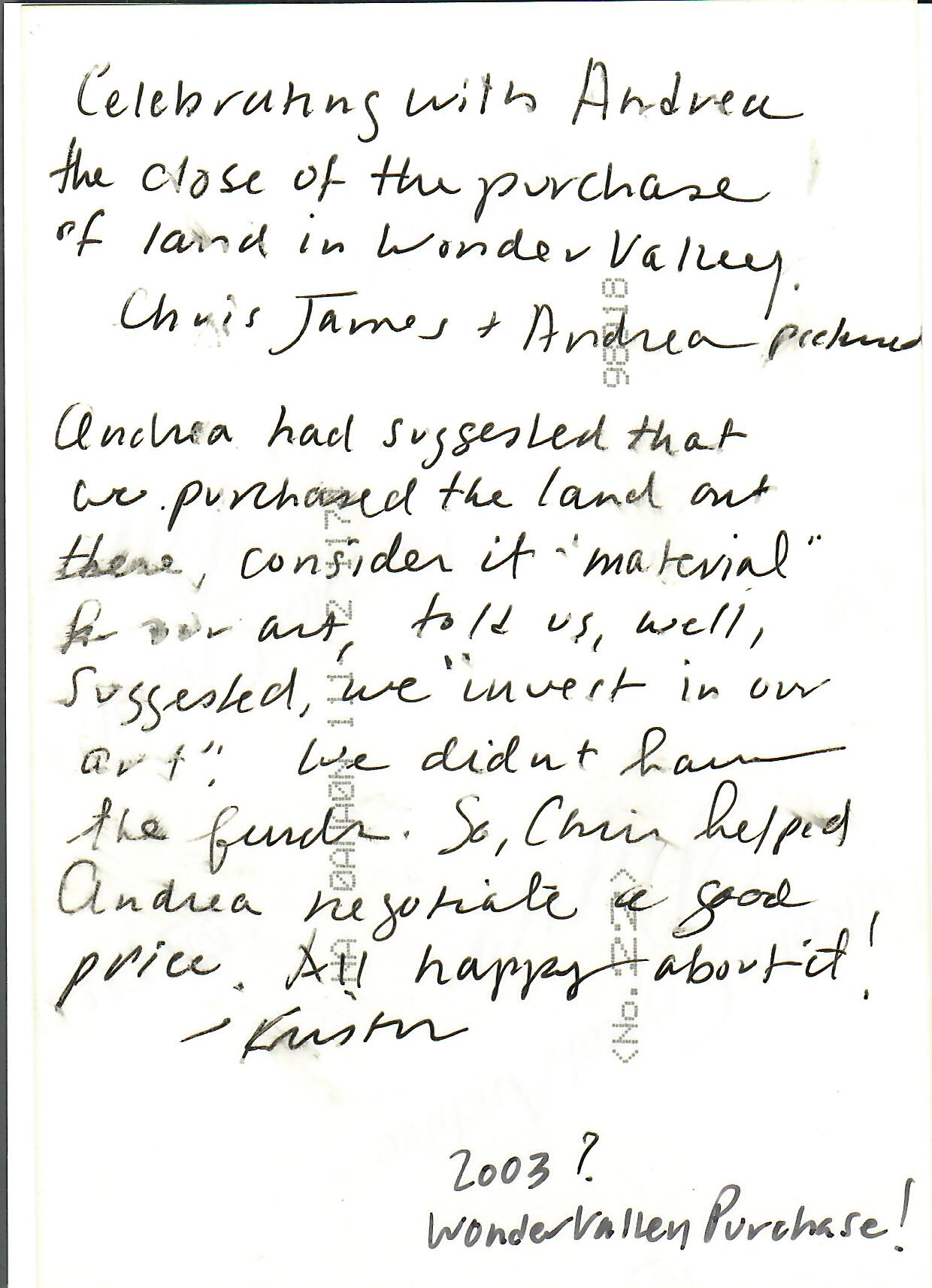
Memory of
¸.·ℳ¸.·´¨)𐌄 ¸.·*¨ɱ)
(¸*.ᴑ·´ (¸.ʀ·´ .·´🄨 ¸
This work has such a long history! Giovanni Jance is a friend and was a frequent collaborator in the 1990s. (He was involved in the Wagon Station customization, our hiking club, and we did a photo collaboration together that involved A-Z West in the very early days. His practice is primarily photography and video.
Giovanni originally planted this large metal arrow along the side of the road at the point where most people entered the Pioneertown parcel. At the time the arrow was painted red, and there was a sign next to it that had a topographical map of the area. I’m trying to remember if the sign also said: “you are here” or if I’m just imagining that. I don’t think that he intended it to be a literal marker for the parcel, but it was really useful because people always got lost out there trying to find the location. After the HDTS event we decided to leave the work as a permanent piece, but a few months later someone tried to bash the arrow over, evidently using a truck or strong vehicle. The arrow bent at an angle, but didn’t break off, so after that they painted it brown. We spent so much time trying to figure out who had done it and finally began to suspect that it was probably Garth. Garth would discuss our projects with people who visited his place up the hill from us and would point out which ones he thought were appropriate for the desert and which ones needed altering to make them fit in better with the natural environment. We also found out that he covers everything at his compound with a color of paint that he calls “Garth Tan” – in fact the local Home Depot has this color on file in their system. I’m pretty sure that Giovanni’s arrow was painted Garth Tan.
Later for a following HDTS event, Giovanni had the arrow restored. This time he painted it orange and placed it further out in the middle of Andy’s 100 acres where no one could reach it with a vehicle. The arrow lived there in peace for a number of years until it finally bent and broke off. We are still not sure if the bending was the result of vandalism or of natural weathering.
Memory of
¸.·ℳ¸.·´¨)𐌄 ¸.·*¨ɱ)
(¸*.ᴑ·´ (¸.ʀ·´ .·´🄨 ¸
I wanted to make a postcard of the woodpile on the marine base, and Skylar Haskard was looking for material for his HDTS 4 project. The woodpile is open to the public, and you can get all the free wood you can carry. But you can’t take photos because they store bombs behind the woodpile. I pulled out a camera and all of a sudden there was a situation. An MP arrived and asked all sorts of questions. Now I have a record at the marine base. They even took down the design and location of my tattoos.
Memory of
¸.·ℳ¸.·´¨)𐌄 ¸.·*¨ɱ)
(¸*.ᴑ·´ (¸.ʀ·´ .·´🄨 ¸
My mechanic’s friend found Chris Kasper’s I’M SORRY sign in the wash and was asking about it all over town because he was so perplexed by why someone would put it there.
¸.·ℳ¸.·´¨)𐌄 ¸.·*¨ɱ)
(¸*.ᴑ·´ (¸.ʀ·´ .·´🄨 ¸
When Andy Stillpass, John Connelly and I were trying to come up with a name for High Desert Test Sites, we emailed our options to Aleksandra, who was a mutual friend, and she said “Definitely High Desert Test Sites”, so in a way she is responsible for our name which has at times been a source of confusion since it references the Nevada Nuclear Test Sites and has vaguely militaristic or governmental references to those versed in desert terminology. We later invited Aleksandra to participate in our second event and she sent a zine out of a bunch of photos that she had taken of herself on a previous visit to Joshua Tree. In the photos she is standing on a large graffiti covered rock along Amboy Road at the point when it passes through the Sheephole Mountain range and heads over toward Amboy. In each photo she strikes a different pose of herself as a Joshua Tree.
